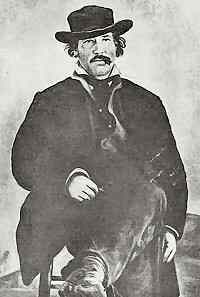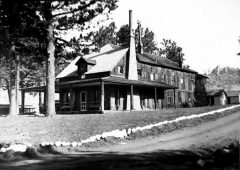The Bar NI is part of what was the 2.7 million acre Maxwell Land Grant. When first seen by Europeans, the Moache Ute and Jicarilla Apache occupied these lands. When the Mexican Government took over the territory, it thought to encourage settlement. It wanted to hold the lands against enemies such as the Navajos, the Americans, and the French. Accordingly, in 1843, it assented to a petition of a Frenchman, Beaubien, and a Mexican, Miranda, residents of Taos, and granted them an ill-defined two million acres in what is now northern New Mexico and southern Colorado.
Three years later, during the early days of the Mexican-American War, the U.S. Army under General Stephen W. Kearney occupied the territory. Beaubien elected to stay, but Miranda fled. Kearney promised, and later the U.S. Government agreed in the Treaty of Guadalupe Hidalgo, to protect the property rights of the inhabitants, which they had enjoyed as citizens of Mexico.

This grant, which son-in-law Lucien Bonaparte Maxwell was soon to acquire from Beaubien, and which subsequently became known as the Maxwell Land Grant, was one of many similar grants. Such lands had little cash value at that time and some were sold for less than one tenth of a cent per acre.
Maxwell settled on the grant near Cimarron, New Mexico. The first Maxwell house was on the Rayado River near the Santa Fe Trail, but he later built a larger home within Cimarron where he gained prominence as a sort of feudal baron with more than 100,000 cattle, horses and sheep, a grist mill, and a store.
There were many arguments and lawsuits about ownership of these lands, especially after gold was discovered in 1866.
The history of the land grant claims is long and complex, but lawsuits questioning these opinions were won by the Maxwell Company and its assignees. Finally, the cases reached the Supreme Court, which, in 1887, upheld the old land grants and denied the settlers their ownership. The Dutch, who had acquired title by then, offered to negotiate and pay each settler for the improvements on land peacefully vacated; but most of these humble farmers were outraged and refused to leave. Led by such firebrands as Reverend O. P. McMains and R. D. Russell of Stonewall, most of the neighborhood people decided to resist eviction. One can hardly blame them for taking rifles and six-shooters to protect their homes. After lives were lost, the federal government intervened to end the bloodshed.
After the fighting was over, and the Maxwell Company all but dissolved, the Colorado Fuel and Iron Corporation (CF&I) acquired what is now the Bar NI Ranch. CF&I, which operated numerous coal mines in the foothills east of the Bar NI, pastured cattle on several hundred thousand acres of the Purgatoire Watershed. This large cattle operation was managed from the Bar NI ranch house. When the operation became unprofitable, the cattle were sold and the pasturage leased to nearby ranchers. For twelve years the house stood abandoned and soon started to disintegrate. Then, in early 1942, it was leased by Cabot Corporation (a privately held company then known as Godfrey L. Cabot, Inc.). Cabot Company personnel could fish and hunt, while the grazing rights continued to be leased to a local rancher for cattle and haying operations.

During the early and mid Twentieth Century, CF&I also put this mountain property to use by harvesting lumber up in the high country, much of which was used for mine props in their several coal mines. In the early days, this lumbering was done by hand saws, and the timber was removed by mule wagons on hand made wagon roads, which can still be seen on parts of the property, as can the remains of some of the old logging camps. By mid century, however, the lumbering had become mechanized, with power saws, bulldozers, and trucks.
In the early 1980’s, the steel industry of the United States suffered very serious reverses. CF&I felt impelled to sell its land and mines, and offered Cabot Corporation a chance to buy 68,000 acres of the mountain land that included the Bar NI and its lodge. But the price seemed exorbitant, and when negotiations failed, the land was subsequently sold to a speculator, Randy Morine.
Morine published slick paper brochures and showed the property to thousands of potential buyers, many of them brought from Texas by private airplane at Morine’s expense. Ultimately, he succeeded in selling to Travis Crawford of El Paso a large tract south of the lodge, including the Abbott and Howlett drainages previously leased by Cabot Corp. and considered by us to be part of the Bar NI. After Morine acquired title, he cancelled the lease arrangement that Cabot Corp. had had with CF&I, and further access to the ranch was denied.
 Morine’s subdivision of the land eventually proved unsuccessful and most of the property reverted to CF&I’s real estate liquidation company. Tom and Virginia Cabot were able to purchase the 27,241 acres north and west of the lodge for the Cabot Family and The Nature Conservancy. Several years later, the family was able to negotiate the purchase of the southern portion of what locals had come to think of as the Bar NI Ranch, thus reconstructing the boundaries containing the 36,000 acres of the property originally leased to Cabot Corp. by CF&I. The property is now held by a family owned corporation, with covenants restricting commercial use. This assures that the primeval quality of this beautiful area will be permanently saved with no possibility that it can be used for development or that any descendant or future assignee can derive any personal profit from it.
Morine’s subdivision of the land eventually proved unsuccessful and most of the property reverted to CF&I’s real estate liquidation company. Tom and Virginia Cabot were able to purchase the 27,241 acres north and west of the lodge for the Cabot Family and The Nature Conservancy. Several years later, the family was able to negotiate the purchase of the southern portion of what locals had come to think of as the Bar NI Ranch, thus reconstructing the boundaries containing the 36,000 acres of the property originally leased to Cabot Corp. by CF&I. The property is now held by a family owned corporation, with covenants restricting commercial use. This assures that the primeval quality of this beautiful area will be permanently saved with no possibility that it can be used for development or that any descendant or future assignee can derive any personal profit from it.

